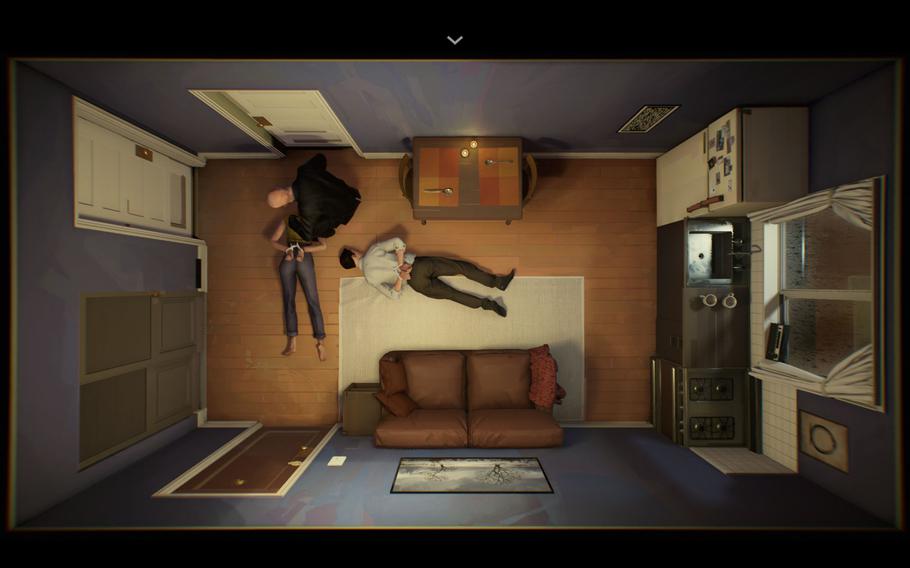
Twelve Minutes, which advertises itself as an “interactive thriller,” is actually a disguised point-and-click adventure game. (Annapurna Interactive)
Annapurna Interactive's enduring success creating enjoyable, experimental storytelling games continues with Twelve Minutes. The game, now available on Xbox and PC, centers on a time loop scenario where the main character and his wife are brutally murdered by someone posing as a cop, forcing players to repeat the same 12 minutes of that night to discover the motive for the murder and your wife's mysterious past.
Twelve Minutes, which advertises itself as an "interactive thriller," is actually a disguised point-and-click adventure game, and it's unlike any other I've played. While the game still falls victim to the shortcomings of the point-and-click genre — like repetition and frustrating guess-and-test gameplay — the spectacularly strange story more than makes up for it, leading to unexpected outcomes and plenty of "aha" moments that will motivate players to keep repeating the loop.
James McAvoy, Daisy Ridley and Willem Dafoe all lend their voice-acting talents in this star-studded cast. Unsurprisingly, Dafoe — doomed to be forever typecast as the bad guy — plays the bad guy. All three turn in a great, credible performances, which is impressive considering the game’s limited graphics and the top-down view obscuring the characters’ facial expressions. Daisy Ridley in particular is impressive, sporting an American accent and an emotional range of which Rey from “Star Wars” could only dream.
The true appeal of the game, however, comes in its gameplay. During the first time loop of the story — a seemingly innocent date night ruined by Dafoe's murderous rampage — you'll discover details, branching dialogue choices and objects you can interact with in the household that'll lead to different outcomes for the story.
In one loop, you might try to be the perfect date, setting up the table, dancing with your wife and telling her how excited you are to have a baby with her. In another loop, you might brutally stab your wife right at the beginning just to see what happens.
The game never makes explicit how to stop the time loop (or even why it's occurring in the first place). Therefore, every loop the player does encourages experimentation and information gathering, untying the knot of a story much more complex and sinister than it appears on the surface. By the time you discover the true story underlying the game, you'll have a completely different outlook on the characters and your feelings toward them.

In the point-and-click adventure game Twelve Minutes, players repeat the same 12 minutes on a time loop to try to get to the bottom of a mystery. (Annapurna Interactive)
This emotional journey — and switch of the player's perceptions of the characters — is the game's greatest strength. However, "advancing the story" itself is the game's biggest weakness.
You'll soon discover after a few loops that Twelve Minutes is a cleverly disguised point-and-click adventure game, a genre whose gameplay is exactly as it sounds. First popularized by Sierra Entertainment games like King's Quest and Space Quest, the genre typically follows a format where "you must have this item and do this thing at this location to advance the story."
Sometimes, that gameplay leads to highly illogical solutions to puzzle problems. In King's Quest V, for example, you have to defeat a wild yeti charging at you by throwing a pie in its face — a pie that you can only purchase several hours earlier in the game.
Fortunately, there's never anything as illogical as a yeti pie toss in Twelve Minutes. Every solution has a certain amount of sense to it and reveals more information about the overall story. Discovering these solutions can be incredibly cathartic, as they involve not only finding and using the right items at the right times, but also using your powers of intuition, observation and deduction.
Unfortunately, unraveling these puzzles can lead to a lot of tedium, as you die over and over again attempting to find the precise item that will advance the story. The game has a couple of mechanics to counter this — characters will spout new timesaving dialogue whenever you discover something big to progress the ultimate solution faster, and you can also simply leave your apartment if you ever want to restart a time loop. But it still takes a few minutes on average to return to a point where you might've screwed up in a loop, which in my playthrough led to several frustrating moments where I was rendered immobile, unable to leave the apartment to reboot, and thinking "JUST MURDER ME ALREADY!" to get another shot at the puzzle.
But overall, this is the only really glaring negative with the game. Twelve Minutes is another example of Annapurna's ability to tell stories in video games in unique ways. After the 10 or so hours required to beat this game, you'll be craving more inspired storytelling like this in other games ... and maybe in one of them Dafoe won't be cast as the bad guy.
Platforms: PC, Xbox One, Xbox Series X/S
Online: twelveminutesgame.com